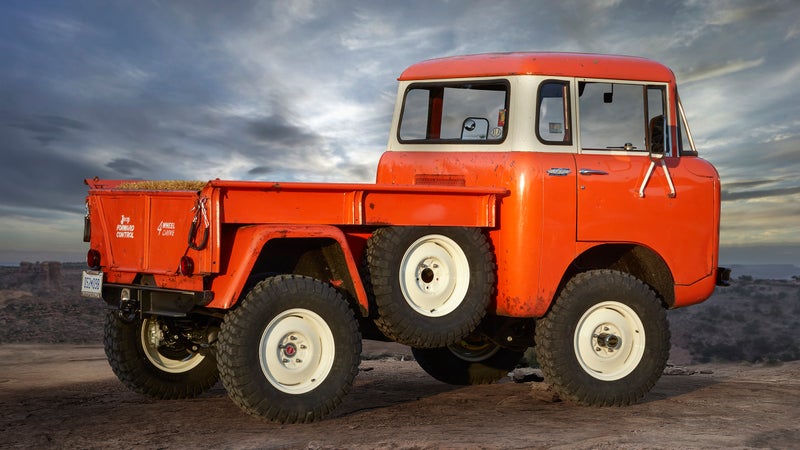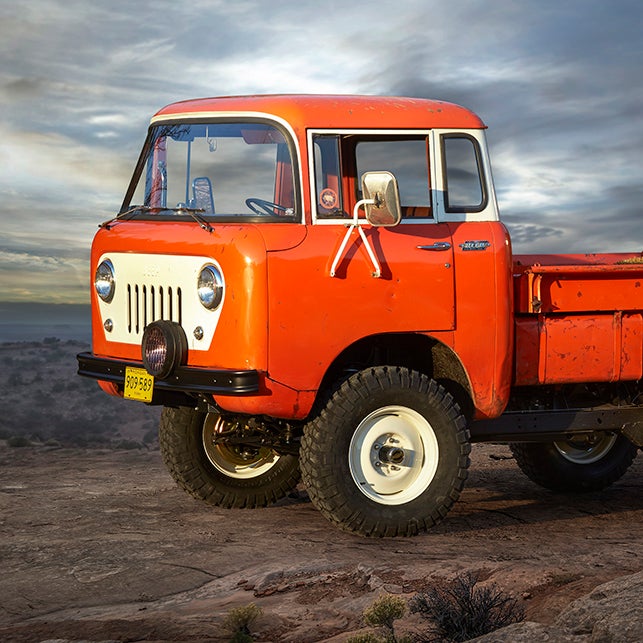Each year, Jeep turns its designers loose, giving them the ability to produce six to seven fully-functional concepts, then sending them to Moab, Utah—where off-road driving was invented—to hoon them. This year, those concepts hint at the next Wrangler, Wrangler pickup, and Grand Wagoneer. Then there’s this thing, which carries no bearing on future products whatsoever. Instead, head of Jeep design Mark Allen built it for himself. Here’s how.
“My attraction to the FC [Forward Control] was because it represents a bygone era when just anything would go with car design and packaging. There were no rules,” says Allen. “Back then, a lot of people made forward control trucks, but very few of them were four-wheel drive like this Jeep.”
Forward control vehicles are the result of purely rational packaging. This Jeep, for instance, is only 11-feet long, but has a six-foot cargo bed. The downside to that extraordinary space-to-size ratio? Safety. The cab hangs out in front of the engine, exposing the occupants to collisions without any protection. “When you’re sitting in the cab, your knee is about four inches behind the front bumper,” says Allen. “You’re the first responder.”
The Jeep design team found this particular FC online, while searching for inspiration. Right away, they knew they had to have it, so they bought it sight-unseen and shipped it back to their studio in Detroit. “It showed up with lots of wear and dents and tears and scratches—stuff that it had earned,” says Allen. “We chose not to repair any of that.” Wherever possible, Allen’s team retained the original patina.

The biggest challenge lay in making it road (and slick-rock) worthy. “I drove the vehicle right when we got it, and it was just unsafe for anybody.” To fix that, Allen sourced the frame and motor from a mid-2000s Jeep Wrangler, then shortened it to fit. “What that brought to the FC was fuel-injection, power steering, power brakes, and everything you need to use it safely,” says Allen. He even fitted Jeep’s legendary 4.0-liter straight-six, complete with an automatic gearbox, under the original, faded engine cover that sits between the seats, in the FC’s cab. The original radiator was too small, so a new one rides on the back of the cab, complete with an electric cooling fan.
Of course, the extra weight from such a large motor in the front of the truck had to be balanced. “Behind the rear axle is a 25-pound cast-iron deadweight,” says Allen. “Call it the ‘Dynamic Chassis Control Unit.' We also put a Dana 60 axle on the rear, just for the weight, and plated the bottom of the cargo box. It’s actually balanced really nicely now.”
The updates didn’t stop with mechanical parts. Inside, the headlining is pulled out of an old flannel sleeping bag. On it? Vintage duck hunting scenes. A pack of unfiltered Camels rides on the dash board, a tin cup is bolted to the engine cover as a cup holder, and xeroxed copies of the Jeep’s old service history, parking tickets, and registrations are rubber-banded to the sun visors.
A bale of hay rides in the bed. “It’s a tractor you can drive to down,” says Allen. “They were used on farms, they were used at service stations, that sort of thing.”
Allen will be wheeling his new FC150 on the slick rock trails at Moab this weekend. “I have a lot of affection for it,” the designer proclaims.


